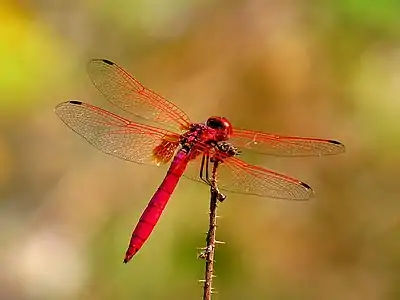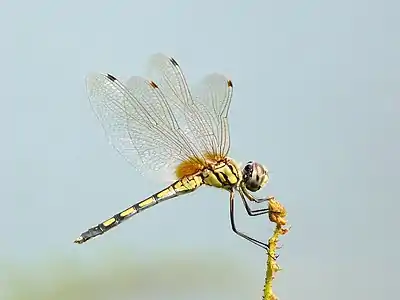Trithemis
Trithemis is a genus of dragonflies in the family Libellulidae. They are commonly known as dropwings. There are over 40 species, mainly from Africa; two are endemic to Madagascar, and five are endemic to Asia.[1] They are found in a wide variety of habitats; some species being adapted to permanent streams in forests, and others being capable of breeding in temporary pools in deserts.[2]
| Trithemis | |
|---|---|
 | |
| Trithemis annulata | |
| Scientific classification | |
| Kingdom: | Animalia |
| Phylum: | Arthropoda |
| Class: | Insecta |
| Order: | Odonata |
| Infraorder: | Anisoptera |
| Family: | Libellulidae |
| Genus: | Trithemis Brauer, 1868 |
The genus contains the following species:[3]
- Trithemis aconita Lieftinck, 1969 – monkshood dropwing,[4] halfshade dropwing[1]
- Trithemis aenea Pinhey, 1961 – bronze dropwing[1]
- Trithemis aequalis Lieftinck, 1969 – swamp dropwing[1]
- Trithemis africana (Brauer, 1867) - western phantom dropwing[5]
- Trithemis annulata (Palisot de Beauvois, 1805) – violet dropwing,[4][6] violet-marked darter[7]
- Trithemis anomala Pinhey, 1955 – striped dropwing[1]
- Trithemis arteriosa (Burmeister, 1839) – red-veined dropwing[4]
- Trithemis aurora (Burmeister, 1839) – crimson marsh glider[8]
- Trithemis basitincta Ris, 1912
- Trithemis bifida Pinhey, 1970 – shadow dropwing[1]
- Trithemis bredoi Fraser, 1953 – river dropwing[1]
- Trithemis brydeni Pinhey, 1970 – percher-like dropwing[1]
- Trithemis congolica Pinhey, 1970 – Congo dropwing[1]
- Trithemis dejouxi Pinhey, 1978 – stonewash dropwing[1]
- Trithemis dichroa Karsch, 1893 - small dropwing,[9] black dropwing[1]
- Trithemis donaldsoni (Calvert, 1899) – denim dropwing[4]
- Trithemis dorsalis (Rambur, 1842) – round-hook dropwing,[4] highland dropwing[1]
- Trithemis ellenbeckii Förster, 1906 – Ethiopian dropwing[1]
- Trithemis festiva (Rambur, 1842) – indigo dropwing,[6] black stream glider[8]
- Trithemis fumosa Pinhey, 1962
- Trithemis furva Karsch, 1899 – navy dropwing[4]
- Trithemis grouti Pinhey, 1961 - black dropwing,[10] dark dropwing[1]
- Trithemis hartwigi Pinhey, 1970 – superb dropwing[1]
- Trithemis hecate Ris, 1912 – silhouette dropwing,[4] hecate dropwing[11]
- Trithemis hinnula Dijkstra, Mézière & Kipping, 2015 – mule dropwing[12]
- Trithemis imitata Pinhey, 1961 – copycat dropwing[1]
- Trithemis integra Dijkstra, 2007 – Albertine dropwing[1]
- Trithemis kalula Kirby, 1900 – pretty dropwing[1]
- Trithemis kirbyi Selys, 1891 – orange-winged dropwing,[6] Kirby's dropwing[4]
- Trithemis legrandi Dijkstra, Mézière & Kipping, 2015[12] – robust dropwing[12]
- Trithemis lilacina Förster, 1899
- Trithemis longistyla (Fraser, 1953)
- Trithemis monardi Ris, 1931 - Monard's dropwing,[13] fluttering dropwing[1]
- Trithemis morrisoni Damm & Hadrys, 2009 – rapids dropwing[1]
- Trithemis nigra Longfield, 1936
- Trithemis nuptialis Karsch, 1894 - hairy-legged dropwing[14]
- Trithemis osvaldae d'Andrea & Carfi, 1997
- Trithemis pallidinervis (Kirby, 1889) - long-legged marsh glider[8]
- Trithemis palustris Damm & Hadrys, 2009 – marsh dropwing[1]
- Trithemis persephone Ris, 1912
- Trithemis pluvialis Förster, 1906 – riffle-and-reed dropwing,[4] river dropwing,[15] russet dropwing[1]
- Trithemis pruinata Karsch, 1899 – cobalt dropwing[1]
- Trithemis selika Selys, 1869
- Trithemis stictica (Burmeister, 1839) – jaunty dropwing[4]
- Trithemis werneri Ris, 1912 – elegant dropwing[4]
 male T. aurora
male T. aurora male T. festiva
male T. festiva female T. pallidinervis
female T. pallidinervis_male.jpg.webp) male T. selika
male T. selika_young_male.jpg.webp) young male T. selika
young male T. selika_female.jpg.webp) female T. selika
female T. selika_young_male_obelisk_composite.jpg.webp) young male T. selika moving into obelisk position
young male T. selika moving into obelisk position
References
- Dijkstra, K.-D.B.; Clausnitzer, V. (2014). The dragonflies and damselflies of eastern Africa. Tervuren: Royal Museum for Central Africa. ISBN 978-94-916-1506-1.
- Damm, S.; Dijkstra, K. D. B.; Hadrys, H. (2010). "Red drifters and dark residents: the phylogeny and ecology of a Plio-Pleistocene dragonfly radiation reflects Africa's changing environment (Odonata, Libellulidae, Trithemis)" (PDF). Molecular Phylogenetics and Evolution. 54 (3): 870–882. doi:10.1016/j.ympev.2009.12.006. PMID 20004729.
- Martin Schorr; Dennis Paulson. "World Odonata List". University of Puget Sound. Retrieved 12 October 2018.
- Samways, Michael J. (2008). The Dragonflies and Damselflies of South Africa. Pensoft. ISBN 954-642-330-0.
- Clausnitzer, V. & Dijkstra, K.-D.B. (2010). "Trithemis africana". IUCN Red List of Threatened Species. 2010: e.T169243A6596888. doi:10.2305/IUCN.UK.2010-3.RLTS.T169243A6596888.en.
- "Checklist, English common names". DragonflyPix.com. Archived from the original on 4 December 2012. Retrieved 5 August 2010.
- Clausnitzer, V. (2006). "Trithemis annulata". IUCN Red List of Threatened Species. 2006. Retrieved 28 November 2010.CS1 maint: ref=harv (link)
- Subramanian, K. A. (2005). Dragonflies and Damselflies of Peninsular India (PDF).
- Clausnitzer, V.; Suhling, F. & Dijkstra, K.-D.B. (2009). "Trithemis dichroa". IUCN Red List of Threatened Species. 2009. Retrieved 28 November 2010.CS1 maint: ref=harv (link)
- Clausnitzer, V.; Suhling, F. & Dijkstra, K.-D.B. (2009). "Trithemis grouti". IUCN Red List of Threatened Species. 2009. Retrieved 28 November 2010.CS1 maint: ref=harv (link)
- Clausnitzer, V.; Suhling, F. & Dijkstra, K.-D.B. (2009). "Trithemis hecate". IUCN Red List of Threatened Species. 2009. Retrieved 28 November 2010.CS1 maint: ref=harv (link)
- Dijkstra, Klaas-Douwe B.; Kipping, Jens; Mézière, Nicolas (2015). "Sixty new dragonfly and damselfly species from Africa (Odonata)" (PDF). Odonatologica. 44 (4): 447–678. Retrieved 16 January 2016.
- Clausnitzer, V.; Suhling, F. & Dijkstra, K.-D.B. (2010). "Trithemis monardi". IUCN Red List of Threatened Species. 2010: e.T60063A12216622. doi:10.2305/IUCN.UK.2010-3.RLTS.T60063A12216622.en.
- Clausnitzer, V.; Suhling, F. & Dijkstra, K.-D.B. (2009). "Trithemis nuptialis". IUCN Red List of Threatened Species. 2009. Retrieved 28 November 2010.CS1 maint: ref=harv (link)
- Clausnitzer, V. & Suhling, F. (2009). "Trithemis pluvialis". IUCN Red List of Threatened Species. 2009. Retrieved 28 November 2010.CS1 maint: ref=harv (link)
This article is issued from Wikipedia. The text is licensed under Creative Commons - Attribution - Sharealike. Additional terms may apply for the media files.